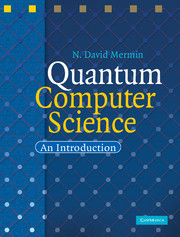4 - Searching with a quantum computer
Published online by Cambridge University Press: 05 June 2012
Summary
The nature of the search
Suppose you know that exactly one n-bit integer satisfies a certain condition, and suppose you have a black-boxed subroutine that acts on the N = 2n different n-bit integers, outputting 1 if the integer satisfies the condition and 0 otherwise. In the absence of any other information, to find the special integer you can do no better with a classical computer than to apply the subroutine repeatedly to different random numbers until you hit on the special one. If you apply it to M different integers the probability of your finding the special number is M/N. You must test ½N different integers to have a 50% chance of success.
If, however, you have a quantum computer with a subroutine that performs such a test, then you can find the special integer with a probability that is very close to 1 when N is large, using a method that calls the subroutine a number of times no greater than.
This very general capability of quantum computers was discovered by Lov Grover, and goes under the name of Grover's search algorithm. Shor's period-finding algorithm and Grover's search algorithm, together with their various modifications and extensions, constitute the two masterpieces of quantum-computational software.
One can think of Grover's black-boxed subroutine in various ways. The subroutine might perform a mathematical calculation to determine whether the input integer is the special one. Here is a simple example.
- Type
- Chapter
- Information
- Quantum Computer ScienceAn Introduction, pp. 88 - 98Publisher: Cambridge University PressPrint publication year: 2007



